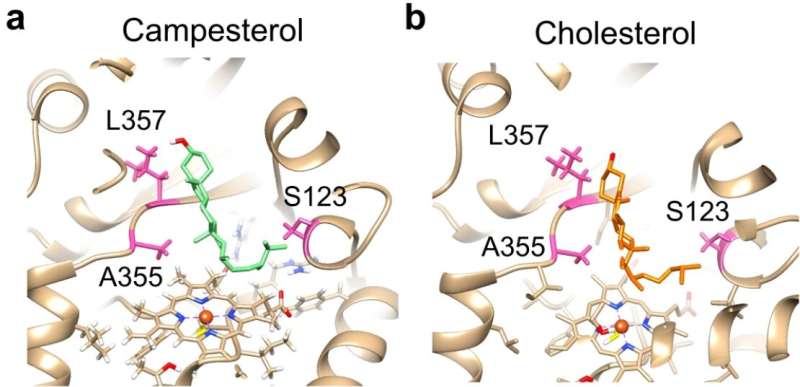This article has been reviewed according to Science X's editorial process and policies. Editors have highlighted the following attributes while ensuring the content's credibility:
fact-checked
peer-reviewed publication
trusted source
proofread
Researchers identify key enzyme for heart failure drug digoxin

University at Buffalo researchers have identified for the first time an enzyme in the foxglove plant that is responsible for the production of compounds needed to make the heart failure drug digoxin.
The breakthrough discovery, described in a paper published July 8 in Nature Communications, builds upon knowledge of the compounds, known as cardiac glycosides. It also could help speed up production of the plant-based drug, which is among the oldest medications used in the field of cariology, and help researchers create less toxic alternatives.
The work was led by Zhen Wang, assistant professor in the Department of Biological Sciences, along with her lab's Ph.D. student Emily Carroll and postdoctoral associate Baradwaj Ravi Gopal, who are both co-first authors.
"The enzyme was speculated for over half a century, but nobody was able to find it until Emily's work. We're the first to discover the enzyme," Wang says.
"I was surprised that, as a young lab with not much experience in this field, we were able to pull it off in a relatively short amount of time and get this to work out. It's been fantastic, it took six years from scratch to discover this enzyme, and we are on our way to discover other enzymes," Wang says. "It's sort of like a dream coming true."
Upbringing exposed professor to herbal medicines
Wang, who joined UB faculty in 2017, says that her upbringing influenced her decision to focus on plant natural products.
"I grew up in China, where I had exposure to traditional Chinese herbal medicines, so that's definitely a cultural connection for me. There are rich resources, and a lot of uncharted area in terms of chemical diversity in plants that will undoubtedly benefit modern medicines," Wang says.
Wang began her lab with the mission of reintroducing medicinal plants and natural products back into the human medicine cabinet.
She focuses on the foxglove because it produces digoxin, which is an accepted plant-based medication that the World Health Organization says is as an essential medication for human health.
Researchers map foxglove's mRNA
Digoxin is produced in the leaves of the foxglove, but not in any other tissues. This led Ravi Gopal to map the mRNA that produces the enzymes—a process called transcriptome analysis—to compare the enzymes present in the leaves and other tissues of the foxglove.
Carroll then tested the function of these enzymes using tobacco and yeast, work that led the discovery of the key enzyme.
Ravi Gopal says his motivation for discovering new ways to produce digoxin is also based on the impending nature of climate change. Producing digoxin through agricultural means will soon become impractical, he says. "We cannot continue with this level of land and water resources being used for production, so this is actually the alternate and more viable way of producing it," he says.
Digoxin takes two years to produce because the foxglove plant must fully mature before the leaves are harvested. "Then the leaves will dry for another year," Wang explains, and after that, "the active component—the medicine—is extracted from the dried leaves. The yield is extremely low, only 0.06% of the plant dry weight."
Carroll says these types of compounds are complex and often difficult to synthesize through organic chemistry. This makes finding an alternative way of producing them important. Plants and other organisms naturally produce these compounds, and she hopes to harness this knowledge to produce the drug more efficiently.
Ravi Gopal hopes the lab's advancements will allow them to produce this compound in a much shorter time period, and more sustainably. "We want to see if we can actually do it overnight, or maybe in a week instead," he said.
What does the future hold?
Wang hopes that the progress made by her lab can lead to faster and more extensive production of digoxin and other cardiac glycosides, by triggering the yeast—microscopic fungi—to produce digoxin.
"We are looking at expanding the utility of this class of compounds because the digoxin can have very severe side effects to patients, that's why it is no longer a frontline medicine for heart failure or atrial fibrillation, but it's still a lifesaving medicine when the patients are not responding to the frontline medications," Wang said. "We are hoping that, by modifying the structure of the digoxin, we will be able to come up with new medicine with as high efficacy and less toxicity."
Producing these compounds with the help of yeast will lead to future advancements to produce other cardiac glycosides that Wang hopes can be used to treat neurodegenerative diseases, cancers and inflammatory illnesses such as arthritis.
"The discovery of this enzyme is like adding a new tool to the existing toolbox that we can then use to make new molecules," says Carroll.
Ravi Gopal says that this process and its implications for the future of medicine is akin to the development of antibiotics from penicillin. Similarly, he thinks they will pave the way for future compounds that will be very similar to the digoxin, which will have a variety of applications.
"It sounds like 10 to 20 years from now," Wang said. "But, instead of using organic chemistry to synthesize these compounds, we're hoping to engineer the microbes to produce a new class of cardiac glycosides with expanding medicinal applications."
More information: Emily Carroll et al, A cytochrome P450 CYP87A4 imparts sterol side-chain cleavage in digoxin biosynthesis, Nature Communications (2023). DOI: 10.1038/s41467-023-39719-4
Journal information: Nature Communications
Provided by University at Buffalo



















